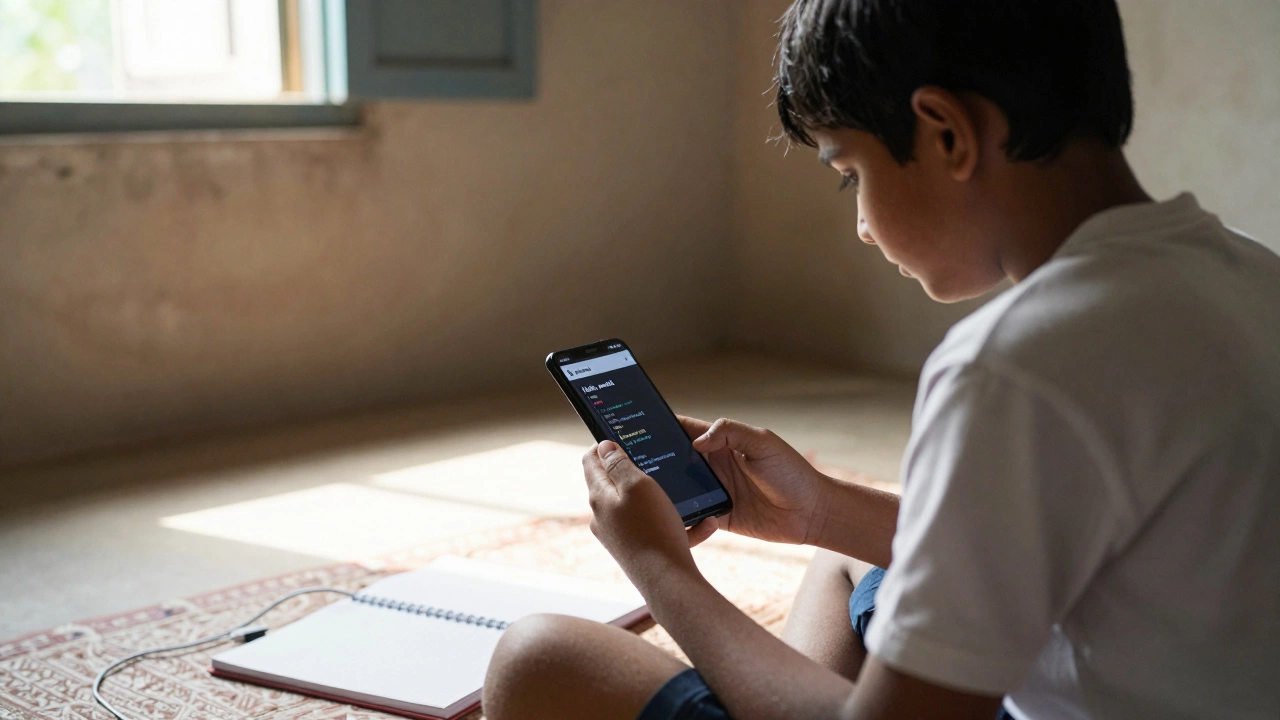Can You Code on Your Phone? Mobile Coding Guide for Android & iOS

You can absolutely write real software on a phone. The trick is choosing the right setup for the job and being honest about limits. Phones are great for quick edits, learning, scripting, and cloud workspaces. They struggle with heavy builds and emulators. If you’re okay leaning on the cloud or a remote machine, you can ship production code without opening a laptop.
- Yes, you can code on a phone-best with cloud IDEs or SSH into a remote dev box; local apps work for lightweight scripts.
- Android is more flexible for terminals and compilers; iOS shines with polished editors and SSH + Git workflows.
- Use a Bluetooth keyboard, good stand, and stable internet; treat the phone as a thin client for big projects.
- Pick your path: Cloud IDE (fastest start), SSH (most power), or local apps (best offline).
- Heavy tools (Docker, emulators, big compiles) belong on a server or cloud workspace, not on the phone itself.
The real answer: when coding on a phone works-and when it’s a pain
Phones are fantastic for small, focused tasks and for connecting to bigger machines. They’re not great for grinding through giant builds or running resource-hungry dev tools locally. Here’s a quick rule of thumb:
- If you need Docker, large dependency graphs, or an emulator: use cloud dev or SSH into a beefy machine.
- If you’re doing HTML/CSS/JS, markdown, docs, quick bug fixes, or scripts: a browser-based IDE or a local coding app is fine.
- If you’ll be offline (flights, commute dead zones): use local interpreters and editors; sync later.
Why this works: your phone is a great thin client. Modern browsers handle web IDEs smoothly, and SSH gives you a fast lane into servers that do the heavy lifting. Android allows terminal emulators and package managers (Termux). iOS is more locked down for running arbitrary executables (see Apple App Store Review Guidelines 2.5.2), but it excels with polished editors, Git clients, and top-tier SSH terminals.
What I usually do on the train in Sydney: phone on a small stand, Bluetooth keyboard paired, hotspot off to save battery if I’m editing locally, or on with Codespaces for quick PRs. I keep tasks small: write tests, tweak styles, review diffs, update docs, or patch a script.
Expectation check:
- Typing will be slower without a keyboard. Get one. Your wrists will thank you.
- Batteries drain fast under SSH and video previews. Carry a power bank.
- Screen real estate is tight. Learn split-view tricks and editor minimap shortcuts.
Setups that actually work (Android and iOS) with steps
Pick a path. All three of these are practical in 2024-2025. Start with the cloud if you want the fastest win.
code on phone
Path A: Cloud IDEs (fastest start, no server to manage)
Good for: web dev, quick patches, learning, hackathons. Examples: GitHub Codespaces, Replit, StackBlitz, CodeSandbox, Gitpod (via mobile browser).
- Prepare your repo
- Add a devcontainer (for Codespaces/Gitpod). Include your language runtime, tools, and postCreate scripts.
- Commit test tasks into package.json or Makefile so you can run tests easily.
- On your phone
- Use Chrome or Safari. Enable “Request Desktop Site” to get better editor UI.
- Open your cloud IDE and start a workspace. Select a small machine size to save credits, bump up if builds are slow.
- Code comfortably
- Pair a Bluetooth keyboard. Map Caps Lock to Ctrl if you use Vim or Emacs.
- Use the editor’s integrated terminal for npm, pip, or pytest. Keep the terminal in a split pane for logs.
- Preview and share
- Use port forwarding (e.g., Codespaces: forward port 3000) to preview your app in-browser.
- Commit with meaningful messages; push and open a PR straight from the editor.
Notes on providers:
- GitHub Codespaces: best GitHub integration, devcontainers, port forwarding, Codespaces secrets. Check current quotas/credits in your plan.
- Replit: instant projects, great for Python/JS. Good mobile UI. Multiplayer is handy for pair programming.
- StackBlitz/CodeSandbox: excellent for front-end. Fast cold starts, live preview, and framework templates.
Path B: SSH into a remote dev box (most power)
Good for: real work on production-sized repos. You’re using the phone as a terminal; the server does the heavy lifting.
What you need:
- A cloud VM or your home workstation reachable over the internet (e.g., a small 4-8 vCPU instance, or a desktop with Tailscale/ZeroTier).
- Terminal app: Android-Termux or JuiceSSH; iOS-Blink Shell, a-Shell (local), Shelly, or the built-in SSH in some editors.
- GitHub/GitLab access tokens for pulls/pushes, or SSH keys.
Steps:
- Set up the server
- Install your stack: language runtimes, Docker, databases. Create a non-root user.
- Harden SSH: disable password auth, use keys only; change the default port if you want; set up a firewall.
- Generate a key on your phone
- Android (Termux): open Termux, run:
pkg update && pkg install openssh, thenssh-keygen -t ed25519. - iOS (Blink Shell): Settings → Keys → Generate; copy the public key.
- Add the public key to
~/.ssh/authorized_keyson your server.
- Android (Termux): open Termux, run:
- Connect and code
- SSH in:
ssh user@your-server. Clone your repo:git clone .... - Use a terminal editor (Neovim is great on mobile):
sudo apt-get install neovim(Ubuntu) or your distro’s package manager. - Run builds and tests server-side. Use TMUX to keep sessions alive.
- SSH in:
Why it’s solid: you keep your muscle memory, pipelines, and tools. If your laptop dies mid-sprint, your environment is still online. Blink Shell on iOS has first-class keyboard support and mosh integration for flaky networks.
Path C: Local coding apps (best offline; Android is more flexible)
Good for: learning, prototyping, scripting, editing static sites, practicing DSA, and building small utilities.
Android picks:
- Termux (F-Droid): full terminal with a package ecosystem. Install Python, Node.js, Ruby, Git, Neovim:
pkg install python nodejs git neovim. - Pydroid 3: quick Python with pip support and many libs. Great for offline notebooks and scripts.
- Dcoder, Acode, QuickEdit: editors that play nicely with mobile keyboards and file access.
iOS picks:
- Textastic or Kodex: fast editors with syntax highlighting and file providers (iCloud, Working Copy).
- Working Copy: a polished Git client; edit, commit, push; integrates with other editors via Files.
- Pythonista 3: local Python runtime with nice UI modules; solid for automations and scripts.
- Blink Shell: premium SSH client for remote workflows; a-Shell for local POSIX-ish utilities.
Reality check: iOS doesn’t allow general-purpose JIT compilers to download and run arbitrary executables, so “real” local compilers are limited. Android gives you more freedom locally. Both shine when you lean on remote machines.
| Setup | Works Offline | Languages/Tools | Build Power | Cost | Best For |
|---|---|---|---|---|---|
| Cloud IDE (Codespaces/Replit/StackBlitz) | No (needs stable internet) | Most runtimes via container/workspace | High (cloud VM) | Varies (free tiers + paid) | Web dev, quick fixes, PRs |
| SSH to Remote Dev Box | No (needs internet, mosh helps) | Anything your server supports | High (your server’s specs) | Server + app cost | Production repos, serious work |
| Local Apps (Android/iOS) | Yes | Android: broad; iOS: curated | Low-Medium (phone CPU) | Mostly one-time app purchases | Learning, scripts, small sites |

What you can actually build on a phone today
Short answer: a lot more than people think-if you keep the heavy lifting off the device.
Web front-ends (React, Vue, Svelte, Astro)
- Best path: StackBlitz/CodeSandbox (client-side dev servers) or Codespaces (Node in container).
- Flow: create a template → edit components → preview via forwarded port or built-in preview → commit and deploy (Vercel/Netlify integrations work well in browser).
- Tip: turn on editor minimap and word wrap, and use a larger font size to reduce eye strain.
APIs and back-ends
- Best path: Codespaces/SSH so builds and servers run remotely.
- Flow: open repo → run your start script (e.g.,
uvicorn main:app --reload,npm run dev) → run tests → push. - Databases: use managed services or Docker on the server; don’t run DBs locally on the phone.
Python scripting and data tinkering
- Android: Pydroid 3 + Termux + Jupyter (via local server) works well. Install common libs:
pip install requests pandas matplotlib. - iOS: Pythonista for local scripts; for notebooks, try mobile web for JupyterHub or services like Google Colab. Carnets can run Jupyter locally for small datasets.
- Reality: heavy data science belongs on a server or GPU instance; use SSH/remote kernels for real workloads.
Static sites and docs
- Use a Markdown editor + Git (Working Copy on iOS, Termux + Git on Android).
- Preview with local web servers (Android) or the app’s preview features; or push to a branch with a GitHub Pages action to preview live.
DevOps and code review
- Review PRs in the browser or GitHub Mobile. Comment, approve, or request changes.
- Trigger CI/CD via workflows. Rerun failed jobs. Use chatops commands if your org uses them.
- SSH into servers for quick checks: logs, restarts, small hotfixes.
Interview prep and algorithm practice
- LeetCode/HackerRank mobile sites and apps are decent. Pair them with a keyboard to practice under realistic time pressure.
- Save templates in snippets (e.g., common BFS/DFS, two-pointer, binary search shells) to type less.
Mobile automation
- iOS: combine Shortcuts with Pythonista or a-Shell for file and network automations.
- Android: Termux + Termux:API gives you scripts that can interact with device features (within permissions).
Cheatsheets, gear, pitfalls, and a quick FAQ
Fast setup checklist
- Pick your path: Cloud IDE (fast), SSH (power), or local apps (offline).
- Get a Bluetooth keyboard; map Caps → Ctrl if you’re a terminal user.
- Use a light, stable phone stand. Eye-level if possible.
- Install your tools: Termux/Pydroid (Android), Working Copy/Blink/Textastic (iOS).
- Set up SSH keys and test server access before you need it.
- Add aliases and dotfiles to speed up common tasks.
Editor and terminal tips
- Use Neovim or a keyboard-friendly editor. Disable animations. Increase contrast.
- Turn on autosave and format-on-save in cloud IDEs.
- Use split panes: code left, terminal right; or editor top, logs bottom.
- Remap Caps to Ctrl; learn a few essential shortcuts: save, search, multi-cursor/select line.
Performance, battery, and data
- Prefer dark mode. Lower screen brightness. Close background video/streaming.
- On flaky connections, use mosh (Blink/Termux) instead of plain SSH.
- Cache dependencies in your remote workspace to avoid re-downloading on every start.
- Use a power bank on long sessions. Carry a short USB-C/Lightning cable.
Security basics
- Use SSH keys with passphrases; keep private keys in the phone’s secure storage.
- Enable 2FA for GitHub/GitLab. Store tokens in the provider’s mobile app, not notes.
- On public Wi‑Fi, prefer your mobile data or use a trusted VPN.
- Lock your screen quickly; set up remote wipe if the device is lost.
Common pitfalls and how to avoid them
- Big builds timing out in the cloud: choose a larger machine or split the build into smaller steps.
- Editor UI cramped: switch to desktop site in the browser; hide sidebars and rely on file search.
- Lost work on bad connections: turn on autosave; for SSH, use TMUX so sessions survive drops.
- Package installation pain on iOS: don’t fight the sandbox; move the build to a server and edit remotely.
Mini‑FAQ
- Can I run VS Code natively on a phone?
Not fully. You can run VS Code’s web UI in cloud IDEs or code-server in a browser. It feels close enough with a keyboard. - Can I compile Java/C++ locally?
Android: yes, via Termux packages, but it’s slower and clunky for big projects. iOS: limited-use SSH or the cloud. - Can I run Docker on a phone?
Not realistically. Run Docker on a server/cloud and connect from your phone. - Is an iPad better than a phone for coding?
Yes. Bigger screen, better multitasking, and the same SSH/cloud workflows. - What about Git?
Android: Termux Git works well. iOS: Working Copy is excellent and integrates with editors. - Will employers care that I committed from a phone?
No, as long as the code is good and secure. Many devs review PRs on mobile. - What if I need to debug a production issue at 2 a.m.?
SSH in, tail logs, apply a small fix behind a feature flag, and trigger your CI/CD. It’s a perfect mobile use case.
Next steps and troubleshooting
If you’re starting today, here’s a quick decision path:
- Do you need heavy tooling (Docker, big builds, databases)? Yes → SSH or cloud IDE; No → local app or cloud IDE.
- Will you be offline? Yes → local app; No → cloud IDE is fastest.
- On iOS? Prefer SSH + editors + Working Copy. On Android? Termux expands what you can do locally.
Troubleshooting tips:
- Laggy typing in web IDE: switch to desktop site, close extra tabs, disable animations, or use a simpler theme.
- SSH disconnects: use mosh, reduce keepalive interval, or switch networks (tether to mobile data).
- Terminal rendering glitches: try another terminal app, or drop font ligatures in the editor.
- Insufficient permissions editing files on iOS: copy the repo into Working Copy’s storage and use the Files app to access it from your editor.
- Time lost to app switching: learn your editor’s command palette and fuzzy file search to jump quickly.
A quick note on sources: Apple’s App Store Review Guidelines (section 2.5.2) explain code execution limits on iOS; Termux documentation covers its package support and Play Store deprecation; GitHub Codespaces and Replit docs outline current resource limits and pricing. For adoption signals, the Stack Overflow Developer Survey 2024 shows widespread cloud and remote dev tool usage-mobile is a natural extension when you pair it with cloud or SSH.
If you treat your phone as a smart terminal with a few trusted local tools, it becomes a real dev device. Keep the heavy lifting elsewhere, carry a good keyboard, and you’ll be surprised how much you can ship between coffee and the next train stop.
